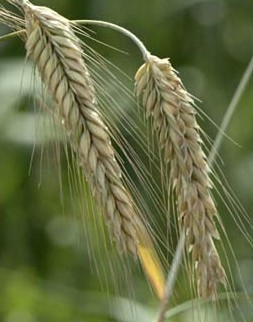 Rye, Secale cereale, is an annual grass related to barley and wheat, and grown for grain, and as a forage and cover crop. It can grow three to six feet tall, has flat leaf blades, and has dense flower spikes. Each spike consists of many spikelets bearing two flowers with long awns. Winter rye is sown in fall when it grows well in the cool temperatures . In spring it initiates growth quickly and produces its crop. Rye is hardier and more drought tolerant than wheat and can be grown on marginal land.
Rye, Secale cereale, is an annual grass related to barley and wheat, and grown for grain, and as a forage and cover crop. It can grow three to six feet tall, has flat leaf blades, and has dense flower spikes. Each spike consists of many spikelets bearing two flowers with long awns. Winter rye is sown in fall when it grows well in the cool temperatures . In spring it initiates growth quickly and produces its crop. Rye is hardier and more drought tolerant than wheat and can be grown on marginal land.
In The Tempest ( act iv, sc. 1, 60 ) Iris, messenger of Juno, implores Ceres to leave her domain and come to perform a masque with Juno to celebrate the engagement of Ferdinand and Miranda.
Ceres, most bounteous lady, thy rich leas
Of wheat, rye, barley, vetches, oats, and peas;
Thy turfy mountains, where live nibbling sheep,
And flat meads thatched with stover, them to keep;
Later (Ibid. act, vi, sc1, 124) Iris invites the field workers to join the nymphs to celebrate;
You sunburnt sicklemen of August weary,
Come hither from the furrow and be merry;
Make holiday; your Rye straw hat put on.
In As You Like It ( act v, sc 3, 23 ) a page sings a song at the request of Touchstone, A clown in Duke Frederick’s court;
Between the acres of the Rye
These pretty country folks would lye.
Evidence of rye has been found in Turkey during Neolithic times and in central Europe in the Bronze Age, c1800-1500 BC. The ancient Romans knew of it but did not like the taste and thought it was a very poor food . By the Middle Ages it was extensively cultivated in central and eastern Europe where it was used in bread. Rye is susceptible to a fungal disease called ergot of rye which has which causes poisoning of people who consume bread made with contaminated rye. The symptoms of the poisoning include paranoia, spasms, and other problems associated with witchcraft in past times suggesting that witch hunts may be linked to rye ergot poisoning. A further association with outbreaks of plague have led to the conclusion that they may be the result of a compromised immune system due to rye ergot.